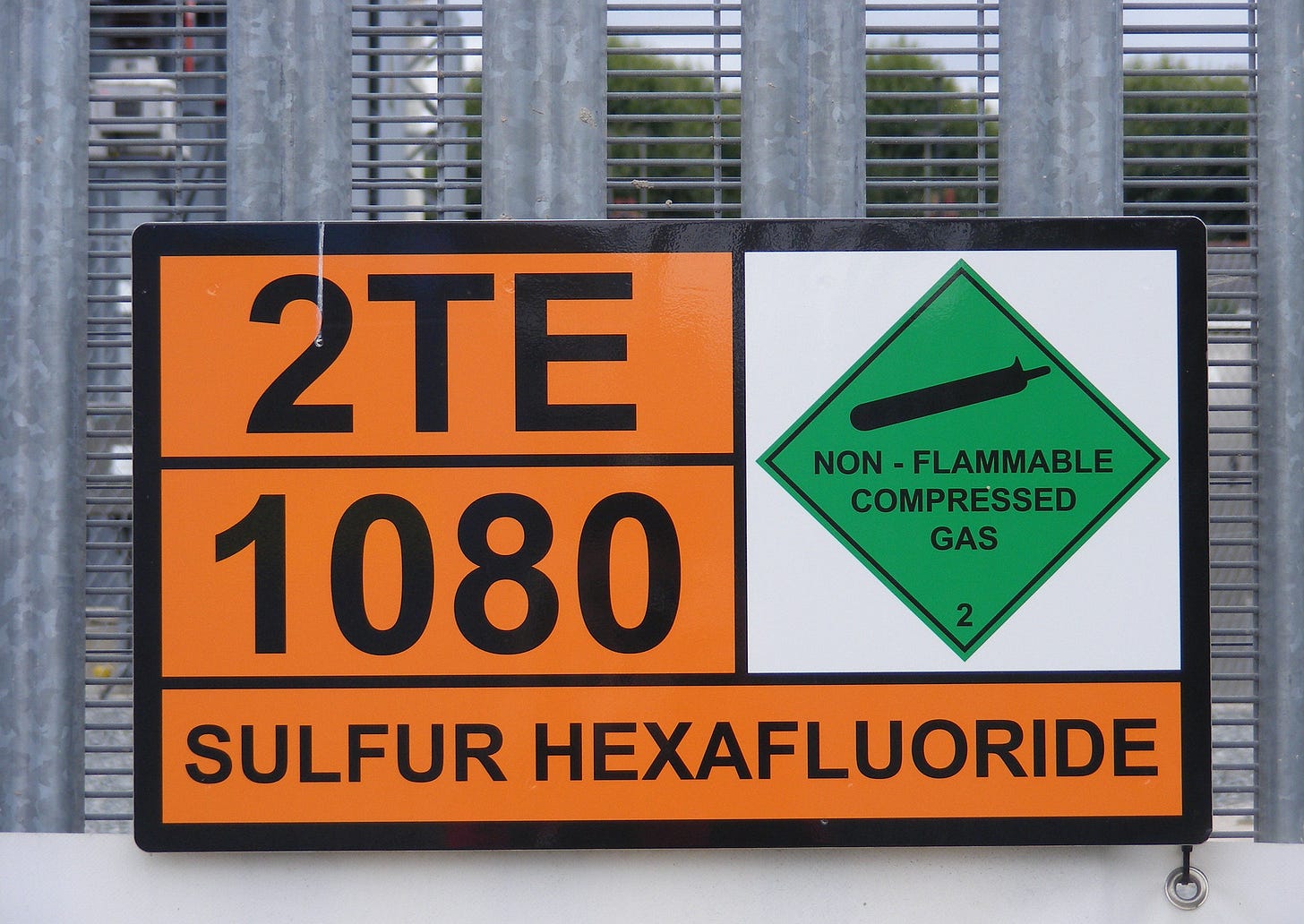Why the world’s most potent greenhouse gas was released in a London Tube station
Sulphur hexafluoride has many fascinating uses – but it’s awful for the climate

As people hurried to and from their trains at St John’s Wood Tube station in north London on Sunday 25 March 2007, traces of a colourless, odourless gas swirled around their feet. It was completely imperceptible to them. The gas flowed up against corners and walls. It spilled over ledges.
Detectors sniffed for it, monitoring how the invisible presence was spreading.
This was a government-run experiment prompted by frightening thoughts. What would happen if somebody tried to poison London’s commuters with a toxic gas? How would the deadly plume diffuse around a busy Tube station?
The gas used in the test was far from toxic – at least not to people. Sulphur hexafluoride, or SF6, is incredibly inert and so safe that you can inhale a deep breath of it for a laugh. It has the opposite effect to helium, it makes your voice go comically deep.
However, SF6 is the most potent greenhouse gas known, with a global warming potential roughly 24,000 times greater than carbon dioxide and an estimated lifespan of around 2,000 years.
Now, The Reengineer can reveal that the experiments, which took place on two days in early 2007 at St John’s Wood station, informed modelling tools that are still in use today – and that the UK Department for Transport paid to offset the environmental impact of using SF6 back in 2007.
Sulphur hexafluoride is useful for air flow studies largely because it is easy to detect in air at very low concentrations, even at just a few parts per million.
SF6 has a long list of other industrial applications, perhaps chiefly as an electrical insulator in switchgear. It has also filled tennis balls, truck tyres and double glazing. Many, many tonnes of SF6 are still in use in electrical equipment and other systems all over the world.
“Some people deem it the most perfect man-made gas – if it wasn’t for the environmental impact,” says Tony Chen at the University of Manchester.
A government statement from 2007 discussing the Tube experiments said, “Small amounts of sulphur hexafluoride will be used to help monitor the movement of air within the station during operational hours.”

As far as I can tell, no further details about the Tube tests have been made public until now. The Reengineer contacted the UK Department for Transport, which confirmed that the gas tests were undertaken in order to inform and validate modelling tools that could predict how a gaseous substance would move around a Tube station, and also down into Tube tunnels themselves.
SF6 was the “only practical gas” identified at the time for these experiments and, given its global warming potential, the Department said it paid to offset its environmental impact. However, it did not share any further details of this offsetting.
Models informed by these tests continue to be used.
Chen says that, if the experiments were ever repeated, it might be possible to use another gas instead, though that would depend on the specific requirements.
SF6 is increasingly the subject of scrutiny. A 2024 study found that annual SF6 emissions in China increased between 2011 and 2021, reaching the equivalent of 125 million tonnes of carbon dioxide. That’s like matching the carbon dioxide emissions of The Netherlands – in SF6 alone – every year.
I asked one of the authors of that study, Matthew Rigby at the University of Cambridge, whether he had any data regarding the environmental impact of the SF6 tracer gas at St John’s Wood station. “Unfortunately, we don’t have SF6 measurements going back that far in the UK network,” he says. “It’d be interesting to see if we spotted it.”
Test and trace
There are many other examples of SF6 being used for airflow studies. In 1985, eight people died in a gas explosion at a block of flats in south-west London. Tests with SF6 later revealed how gas from a nearby gas main may have found its way from a fractured pipe in the ground into the building.
Soil settlement beneath drains had left a passage for the explosive gas to reach the exterior of the building, a report on the tragedy later stated: “It is likely therefore that the gas travelled […] through the gap between the original building footings and the overlaying new walls or alternatively through the poorly mortared joints in the same area, then up the inside of the wall.”
Today, SF6 is gradually being phased out in some industries for climate reasons but it remains widely used in the utilities sector. Arguably, there are more reasons to use it than ever as the world switches away from fossil fuels towards renewables and greater electrification. In electrical switchgear, the gas has an important role as an insulator. Basically, it stops electricity in its tracks, preventing shocks or arcing. In certain “puffer” type circuit breakers, for instance, a power surge will trigger a sudden puff of pressurised SF6, which interrupts the current.
Chen cites data revealing that there are still around 1,500 tonnes of SF6 in use in UK electrical transmission and distribution equipment alone.
Things are gradually changing. National Grid installed the world’s first gas-insulated switchgear featuring an alternative to SF6 back in 2017, at a 400,000 volt substation in Kent.
More recently, governments have taken steps to ban SF6 in electrical equipment. The European Union has introduced various regulations in this vein, for instance, and companies such as Schneider Electric and ABB have developed SF6-free switchgear.
But SF6 has certain properties that make it very reliable. And it has other advantages. “You can really compress the space, the area and volume of substations,” explains Chen.
‘Raging debate’
This means that, if you switch to an alternative gas such as air, you then have to upsize your equipment and use more material overall. However, opting for the gas C4F7N instead of SF6, for instance, does not require larger kit – though there are some complications in using that particular alternative. In sum, there is a “raging debate” in the electrical industry over which choice of gas is ultimately better, including for the planet, says Chen.
It seems that various industries will continue to use SF6 for a long time to come. But as the outsized impact of this little-known gas on the climate gradually becomes better known, Chen argues that efforts to phase it out are gathering pace as a “global trend”.
Many will hope so because, according to data from the US National Oceanic and Atmospheric Administration, levels of SF6 in Earth’s atmosphere have gradually risen higher and higher during the past 25 years.
There’s no sign yet of that slowing down.
Further reading on this week’s story
It’s possible to separate SF6 in order to dispose of it. In 2021, UK researchers reported using an aluminium compound to break it up in a matter of minutes.
A 2020 study details the “increasing atmospheric burden” of SF6 on a global scale.
Thanks for reading! If you enjoyed this story, don’t forget to share it with your friends and colleagues. You can also subscribe to The Reengineer and follow me on Bluesky.



